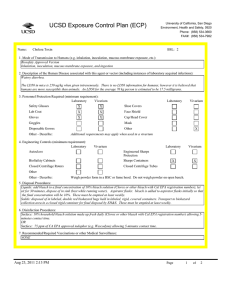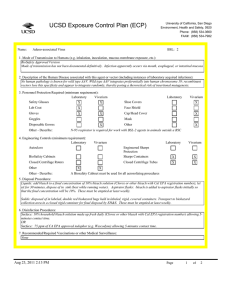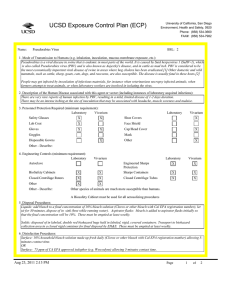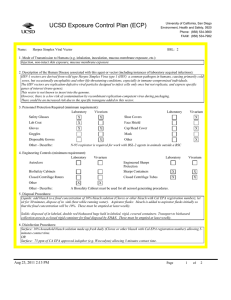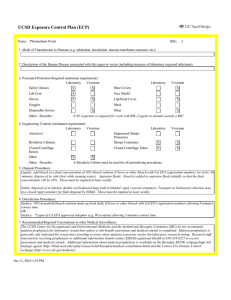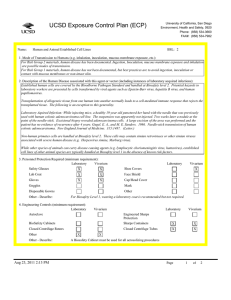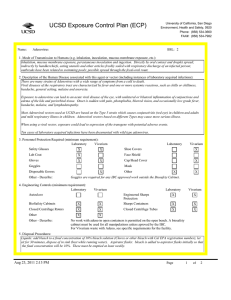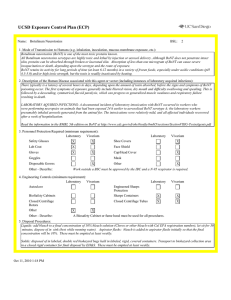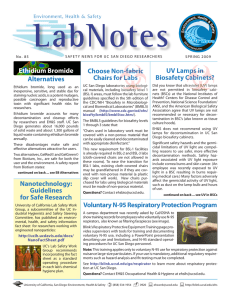UCSD Exposure Control Plan (ECP)
advertisement
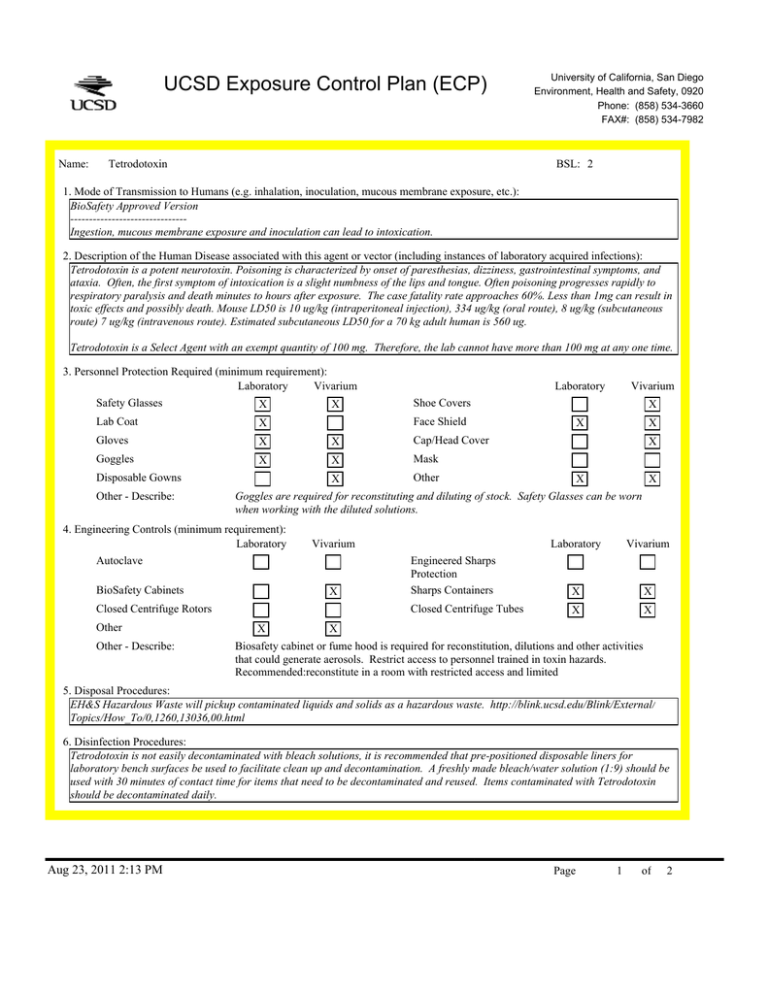
UCSD Exposure Control Plan (ECP) Name: Tetrodotoxin University of California, San Diego Environment, Health and Safety, 0920 Phone: (858) 534-3660 FAX#: (858) 534-7982 BSL: 2 1. Mode of Transmission to Humans (e.g. inhalation, inoculation, mucous membrane exposure, etc.): BioSafety Approved Version ------------------------------Ingestion, mucous membrane exposure and inoculation can lead to intoxication. 2. Description of the Human Disease associated with this agent or vector (including instances of laboratory acquired infections): Tetrodotoxin is a potent neurotoxin. Poisoning is characterized by onset of paresthesias, dizziness, gastrointestinal symptoms, and ataxia. Often, the first symptom of intoxication is a slight numbness of the lips and tongue. Often poisoning progresses rapidly to respiratory paralysis and death minutes to hours after exposure. The case fatality rate approaches 60%. Less than 1mg can result in toxic effects and possibly death. Mouse LD50 is 10 ug/kg (intraperitoneal injection), 334 ug/kg (oral route), 8 ug/kg (subcutaneous route) 7 ug/kg (intravenous route). Estimated subcutaneous LD50 for a 70 kg adult human is 560 ug. Tetrodotoxin is a Select Agent with an exempt quantity of 100 mg. Therefore, the lab cannot have more than 100 mg at any one time. 3. Personnel Protection Required (minimum requirement): Laboratory Vivarium Safety Glasses X X Laboratory Shoe Covers Lab Coat X Gloves X X Cap/Head Cover Goggles X X Mask X Other Disposable Gowns Other - Describe: BioSafety Cabinets Vivarium X Closed Centrifuge Rotors Other - Describe: X Face Shield X X X X X Goggles are required for reconstituting and diluting of stock. Safety Glasses can be worn when working with the diluted solutions. 4. Engineering Controls (minimum requirement): Laboratory Autoclave Other Vivarium X Laboratory Vivarium Engineered Sharps Protection Sharps Containers X X Closed Centrifuge Tubes X X X Biosafety cabinet or fume hood is required for reconstitution, dilutions and other activities that could generate aerosols. Restrict access to personnel trained in toxin hazards. Recommended:reconstitute in a room with restricted access and limited 5. Disposal Procedures: EH&S Hazardous Waste will pickup contaminated liquids and solids as a hazardous waste. http://blink.ucsd.edu/Blink/External/ Topics/How_To/0,1260,13036,00.html 6. Disinfection Procedures: Tetrodotoxin is not easily decontaminated with bleach solutions, it is recommended that pre-positioned disposable liners for laboratory bench surfaces be used to facilitate clean up and decontamination. A freshly made bleach/water solution (1:9) should be used with 30 minutes of contact time for items that need to be decontaminated and reused. Items contaminated with Tetrodotoxin should be decontaminated daily. Aug 23, 2011 2:13 PM Page 1 of 2 UCSD Exposure Control Plan (ECP) 7. Recommended/Required Vaccinations or other Medical Surveillance: None 8. Employee Exposures- first aid procedures: a.Eye exposure from splash or aerosols - rinse a minimum of 15 minutes in eye wash or flush area with water. b.Skin exposure - wash area with soap and water for 15 minutes c.Needle stick and/or sharps exposure - wash wound area with soap and water for 15 minutes d.Contamination of clothing - remove the contaminated clothing and place in biohazard bag, shower with the emergency douse shower, and put on clean clothes. e.Spill or release - Monday through Friday, 8a - 4:30p call EH&S at (858-5343660); after hours call UCSD Police (858-534-4357) 9. Employee Exposure - seek medical follow-up from the following medical providers: (TAKE THIS ECP WITH YOU) Monday - Friday, 8a - 4:30p: UCSD Occupational & Environmental Medicine, (619) 471-9210 24-hour walk-in service: Thornton Hospital Emergency Room, (858) 657-7600 UCSD Medical Center (Hillcrest) Emergency Room, (619) 543-6400 10. Report All Injuries, Illnesses, and Exposures to EH&S: Complete the information found on "What to Do if a Work-Related Injury or Illness Occurs" (http://blink.ucsd.edu/Blink/External/ Topics/How_To/0,1260,4295,00.html) 11. Required Biosafety Training: Laboratory specific training on hazards, exposure evaluations, and the required precautions for experimental procedures used with this agent - provided by Principal Investigator 12. Lab specific instructions: Procedure listed in protocol S03102. Proper safety precautions include the use of lates gloves, googles or face shield, lab coat is used when moving animal. Administration of this agent is to be performed by research staff. The preparation of this agent is done in a chemical fume hood. Aug 23, 2011 2:13 PM Page 2 of 2
